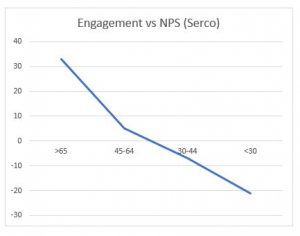
Measuring Makes My Head Hurt
I like measuring things. My carpentry skills would suggest I’m not very good at it, but any lack of skills therein, is perhaps made up in my enthusiasm for measuring other things. If you don’t measure you don’t know how good (or bad) something is and whether it’s getting better or worse.
We recently trialled Net Promoter Score in Delt as another way of looking at customer satisfaction. Although we already measure CSAT several different ways, none of them let us compare with other organisations on a like for like basis. NPS uses a very simple question that’s applicable to almost every business:
On a scale of zero to ten, how likely are you to recommend our business to a friend or colleague?
Customers that give you a 6 or below are detractors, those scoring you 7 or 8 are passives, and a 9 or 10 are promoters. You convert the results to percentages, take the detractors away from the promoters and ignore the passives. You then end up with a number between -100 and 100 which is your net promoter score. Delt’s NPS for 2020 is 33.
Anything above 0 is considered ‘good’ but the point of NPS is to be able to compare, even cross sector. That means we can compare ourselves with Disney, who have an NPS of 50, which is considered excellent. Outsourcer Capita are at 8 and IT specialist DXC (formerly CSC) are -8.
 Whilst researching other organisations results I found something very interesting. Some years ago, Serco looked at NPS by individual contract, rather than across their whole organisation. They also had staff engagement numbers by contract which led me to wonder if there is a correlation between how much your customers like you and how engaged and happy your staff are. It turns out there is. In fact, it’s nearly a straight-line relationship! Happy employees = happy customers.
Whilst researching other organisations results I found something very interesting. Some years ago, Serco looked at NPS by individual contract, rather than across their whole organisation. They also had staff engagement numbers by contract which led me to wonder if there is a correlation between how much your customers like you and how engaged and happy your staff are. It turns out there is. In fact, it’s nearly a straight-line relationship! Happy employees = happy customers.
Or does it?
If we look from the other end of the telescope, are our happy customers making our employees feel loved and needed? The kind of academic brain to answer this sort of question is not to be found inside my head.
What is clear is that we seem to have both mostly happy staff, and mostly happy customers. We’d like more of both. Smarter people than me can figure out if A impacts B, or B impacts A, or if the apparent straight-line correlation between the two is an unfortunate accident of statistics. Until they do, we’ll do our best to improve both.
Giles Letheren
Chief Executive Officer
Photo by Isaac Smith on Unsplash



